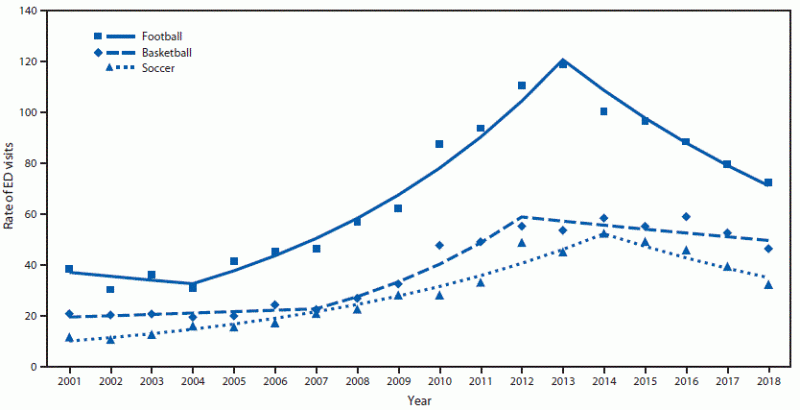Press Releases
CDC report validates CLF's impact on sports concussions
By Chris Nowinski, Ph.D.
Concussion Legacy Foundation co-founder & CEO
When I wrote Head Games: Football’s Concussion Crisis with the help of CLF co-founder and medical director Dr. Robert Cantu in 2006, my goal was not only to educate about the dangers of concussions in football, but also to detail football reforms to prevent concussions. Last week the CDC issued a new study that conclusively shows this campaign of education and reform, led and executed by the Concussion Legacy Foundation, has been successful beyond our wildest imaginations.
On July 9, the U.S. Centers for Disease Control and Prevention (CDC) published Trends in Emergency Department Visits for Contact Sports–Related Traumatic Brain Injuries Among Children — United States, 2001–2018 in their prestigious Morbidity and Mortality Weekly Report. It shows the rate of football-related TBI Emergency Department (ED) visits declined by 39% from 2013 to 2018, after increasing more than 200% from 2001 to 2013. This is the best evidence yet that the Concussion Legacy Foundation has made a profound and long-term positive impact on the health of youth and high school football players.
The data, illustrated in Figure 2 below, reveals that the 200% increase in football-related ED visits from 2001-2013 primarily occurred after 2007. That was the year we began our public-facing education campaign to increase awareness of the risks of concussion, as chronicled in this 2007 HBO Real Sports episode and documentaries like PBS Frontline’s League of Denial and Head Games: The Global Concussion Crisis. We blew the whistle, and concussions that were once ignored now resulted in immediate medical care and better outcomes for football players. The study also showed benefits in increased ED visits for concussions in other sports like basketball and soccer.

After the five-year surge in football-related ED visits reflecting increased awareness, we would have expected to see a plateau in the absence of effective reforms focused on concussion prevention.
Instead, this new data reveals football-related ED visits declined by a remarkable 39% since 2013. The CDC credits the 24% drop in participation in youth tackle football since 2010 as one component of that change. The participation decline coincides with Dr. Cantu speaking out against youth tackle football in his 2012 book Concussions & Our Kids and summarized in this 2012 New York Times Op-ed. His bold proposition inspired CLF’s ongoing Flag Football Under 14 campaign.
The CDC also credits the “implementation of contact and tackling restrictions” as a likely contributing factor to the decline in football-related ED visits. In 2006’s Head Games I wrote, “One simple but radical idea that would reduce concussions is to limit the number of full-contact practices.”
We were not able to implement that reform at the highest level until the NFL Players Association recruited us to the new Mackey-White Health & Safety Committee in 2010. At the first meeting, attended by members, staff, and NFL players, each expert was asked to speak for five minutes on which concussion reform they thought was most important for players.
Dr. Cantu and I knew the evidence showed upwards of 60% of head impacts occur in practice, and no other reform would be as effective at reducing concussions, so we both advocated for contact practice restrictions. We were the only experts to mention it, so I was doubtful it would become policy. Fortunately, the NFL players in the room immediately saw the logic and codified significant contact restrictions in practice into their 2011 Collective Bargaining Agreement. Soon after, as a member of the new Ivy League Concussion Committee, I asked coaches to lead football to a better future by becoming the first college conference to have formal contact limits in the sport. Although these early adopters had already limited hitting in practice below the threshold, they agreed to make it policy. By 2013, the idea began to trickle down to high school and youth coaches, and ED visits for concussions began to decline.
We are not the only individuals or organization that deserves credit for this extraordinary public health victory. We thank the many scientists who published the data that inspired and validated these reforms, Dr. Ann McKee and the Boston University and VA researchers who have taught us about CTE, the families of our brain donors who have made so much of this research possible, members of the football and medical communities who advocated for change, and the many football players and families who have gone public with their struggles.
We are proud to have led the concussion education movement and inspired the reforms to football responsible for the initial increase, and now promising decline, in ED visits for concussions. This movement has undeniably made football players safer. We thank the CDC for compiling and interpreting this important data. Most importantly, Dr. Cantu, the CLF team, and I could not have done this without your support – and for that, we thank you.
But the fight isn’t over. The CDC concludes, “These findings highlight the continued need to expand efforts to prevent football-related TBIs among children and call attention to the need to identify effective prevention strategies for other contact sports.”
We are committed to concussion and CTE prevention through CLF’s Flag Football Under 14 and Safer Soccer programs, which aim to eliminate repetitive head impacts for children before age 14.
We are committed to supporting the generations of former athletes affected by concussions through programs like the CLF HelpLine and Patient & Family Services.
We are committed to accelerating the search for effective treatments for concussions and CTE through the VA-BU-CLF Brain Bank and Brain Donation & Clinical Research Registry.
We are committed to continuing to make a difference. If you’d like CLF to continue to succeed, please make a donation today.